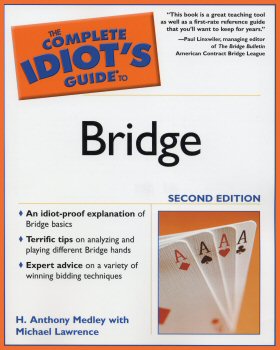| The first edition of Complete Idiot's Guide to Bridge by H. Anthony Medley was the fastest selling beginning bridge book, going through more than 10 printings. This updated Second Edition includes some modern advanced bidding systems and conventions, like Two over One, a system used by many modern tournament players, Roman Key Card Blackwood, New Minor Forcing, Reverse Drury, Forcing No Trump, and others. Also included is a detailed Guide to Bids and Responses, along with the most detailed, 12-page Glossary ever published, as well as examples to make learning the game even easier. Click book to order. | ||
|
Black Swan (7/10) by Tony Medley Run time 108 minutes. Not for children. I don’t know what director Darren Aronofsky has against ballet, but he takes whatever it is out on the art in this horror film starring Natalie Portman as Nina Sayers, the ballerina chosen to play the Black Swan in Thomas Leroy’s (Vincent Cassel, who gives another fine performance after sparkling in the 2008 Mesrine films) production of Swan Lake. Aronofsky takes a script with four separate credits and pieces together a troubling story of a girl Thomas thinks needs to break out from her sheltered existence. The result is a scene of lesbian oral sex that originally got the film an NC-17 rating, which is meant to symbolize Nina finally letting go, although I don’t know why a heterosexual sex scene wouldn’t have accomplished the same purpose. The Weinstein Company fought it and finally the MPAA relented and gave it an R rating. There is no nudity in the film, but the lesbian oral sex scene is graphic. Nina has a smothering ballet mother, Erica (Barbara Hershey), who is as devoted to Nina’s career as Nina is herself. Maybe this is realistic, because I do know from personal experience how much time mothers devote to their ballerina daughters training and careers, but that’s about the only thing that’s realistic about this film. The dancing is disappointing, to say the least. When someone is spending the time and money to bring a ballet story to the screen, one would think that there would be a lot of effort to ensure the dancing is high quality. Someone dropped the ball here, because the dancing scenes of the Corps de Ballet are sloppy. Whoever was directing them wouldn’t make it even with the Rockettes, much less a major ballet company. Even so, the film is interesting as Nina fights her demons, all the while trying to satisfy Thomas to achieve the performance of which he tells her she is capable. But that doesn’t mean it’s easy to watch. In addition to the sex scene, there are several scenes of graphic violence. I happened to sit by a ballerina who had worked in The Turning Point (1977), a fine movie about ballet. She was incensed at the treatment of ballet in general and the ballerinas in particular, and felt that Thomas’s sexual advances on Nina were absurd. Another friend found the film “laughable.” The ending leads one to wonder what was real and what was fantasy in what came before. Even though I thought it a troubling, unrealistic excursion into a director’s phantasmagoric brain, I still found it absorbing, and I’m not an aficionado of horror films or ballet.
|
||
